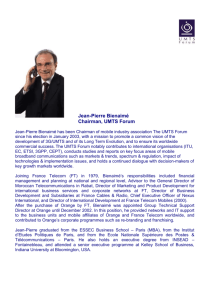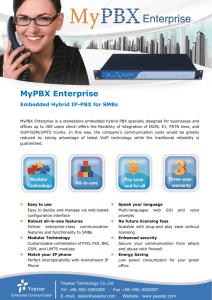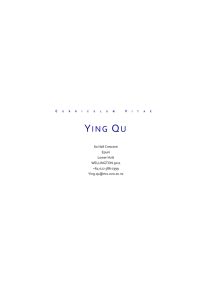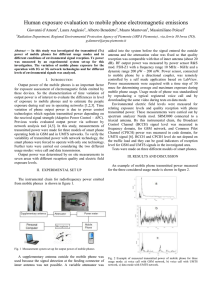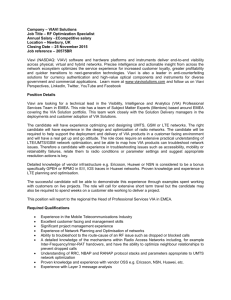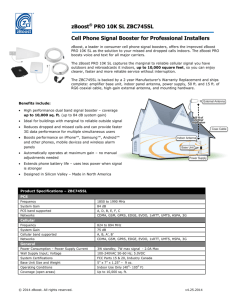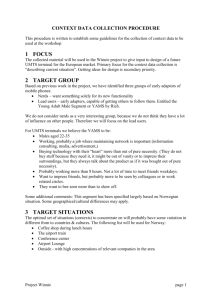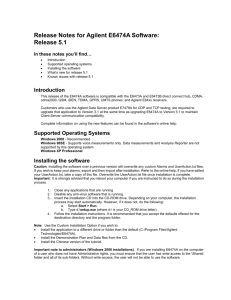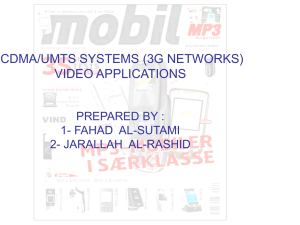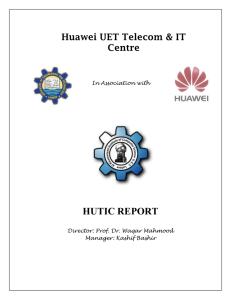UMTS - Universal Mobile Telephone System
advertisement
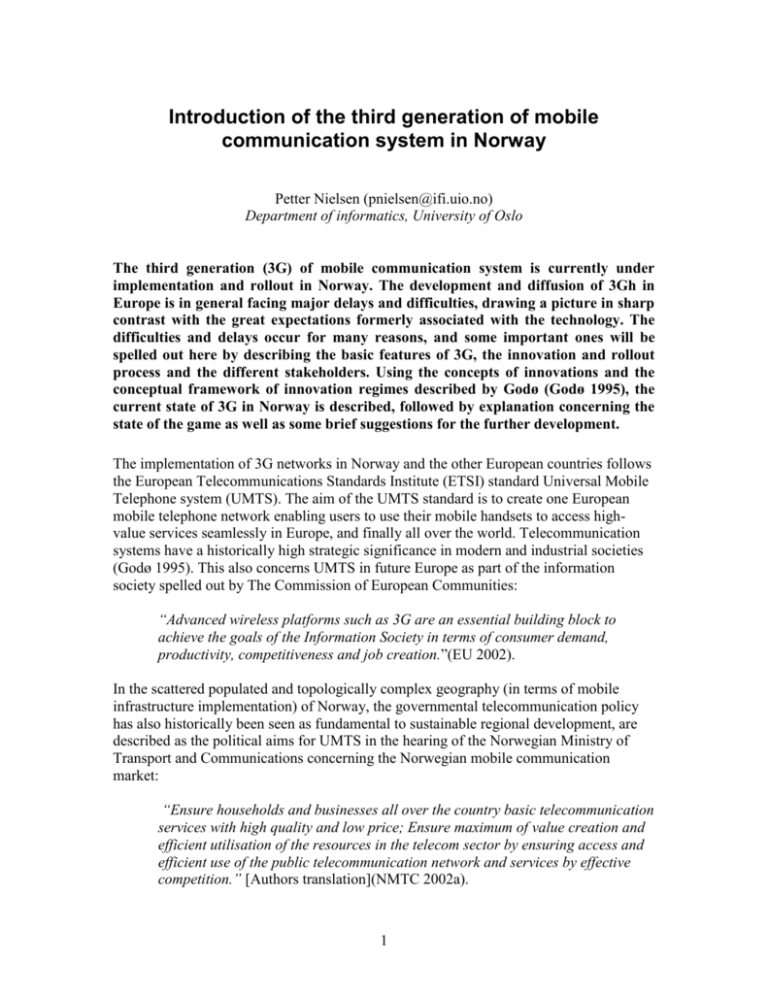
Introduction of the third generation of mobile communication system in Norway Petter Nielsen (pnielsen@ifi.uio.no) Department of informatics, University of Oslo The third generation (3G) of mobile communication system is currently under implementation and rollout in Norway. The development and diffusion of 3Gh in Europe is in general facing major delays and difficulties, drawing a picture in sharp contrast with the great expectations formerly associated with the technology. The difficulties and delays occur for many reasons, and some important ones will be spelled out here by describing the basic features of 3G, the innovation and rollout process and the different stakeholders. Using the concepts of innovations and the conceptual framework of innovation regimes described by Godø (Godø 1995), the current state of 3G in Norway is described, followed by explanation concerning the state of the game as well as some brief suggestions for the further development. The implementation of 3G networks in Norway and the other European countries follows the European Telecommunications Standards Institute (ETSI) standard Universal Mobile Telephone system (UMTS). The aim of the UMTS standard is to create one European mobile telephone network enabling users to use their mobile handsets to access highvalue services seamlessly in Europe, and finally all over the world. Telecommunication systems have a historically high strategic significance in modern and industrial societies (Godø 1995). This also concerns UMTS in future Europe as part of the information society spelled out by The Commission of European Communities: “Advanced wireless platforms such as 3G are an essential building block to achieve the goals of the Information Society in terms of consumer demand, productivity, competitiveness and job creation.”(EU 2002). In the scattered populated and topologically complex geography (in terms of mobile infrastructure implementation) of Norway, the governmental telecommunication policy has also historically been seen as fundamental to sustainable regional development, are described as the political aims for UMTS in the hearing of the Norwegian Ministry of Transport and Communications concerning the Norwegian mobile communication market: “Ensure households and businesses all over the country basic telecommunication services with high quality and low price; Ensure maximum of value creation and efficient utilisation of the resources in the telecom sector by ensuring access and efficient use of the public telecommunication network and services by effective competition.” [Authors translation](NMTC 2002a). 1 Telecommunication is in addition seen as a source for industrial and job opportunities, by exporting technology and knowledge to other European and non-European countries (NMTC 1999). The achievement of these stated aims is expected to come by enabling effective competition in a liberalised telecommunication market. In the case of Norway it can be argued that policy makers and the telecommunication operators both have to meet the classical challenges for less developed regions of the world described by McDowell: The expansion of the telecommunication infrastructure due to the geographical challenges, and the challenges for the post-industrial North: the issues of competition, pricing, and social objectives (McDowell 2001), to succeed in implementing UMTS. The strategic importance of telecommunication is also reflected in the numerous national and international governmental bodies concerned with the use of frequencies, attribution of licences and competition. In Norway, the Norwegian Ministry of Transportation and Communication, the Norwegian Post and Telecommunications Authority, the International Telecommunication Union (ITU) and different EU1 bodies have the major stake in the current regulation policies. The operators and other stakeholders are also given a voice in numerous hearings. National regulations in telecommunication have in Norway lately undergone changes as to suite the relatively newly deregulated and liberalised European telecommunication market. The deregulation has resulted in an open market, where the monopoly situation of the state owned “Televerket” no longer exists de jure. De facto, Telenor (formerly “Televerket”) still has a significant market position in mobile communication, and together with the second largest operator: NetCom, respectively having 62.5% and 26.3% percent of subscriptions and 70.2% and 21.4% of the traffic minutes (Statistics for 2001, NPTA 2002a), the market are basically a duopoly. The strong position of Telenor have been an important issue for national regulation bodies, trying to secure the access to the existing European mobile communication system GSM network and the market for new entrants (as for example Sense, the third largest operator having 5.44% of subscriptions and 4.69% of traffic minutes) to create effective competition and correct pricing of the services. Actors (Telenor and NetCom only) with their own physical network have obviously more flexibility than the operators and service providers without. This is acknowledged by the Ministry of Transportation and Communication through obligating licensees to build parallel and completely independent UMTS networks. 1. Sharing the air Radio frequencies combined with antennas and transmission effect enables communication over different ranges. The different ranges make some frequencies more popular than other, and they eventually become crowded. Radio frequency regulation authorities are responsible for regulating the use of different frequencies so that communication doesn’t break down, as well enabling a maximum of utilization. Regulations are implemented by licensing the use and appropriate the different parts of the frequency spectrum to different purposes, and different licensees. GSM and UMTS 1 Norway is not a member state of the European Union, but is associated by the European Economic Area (EEA). Norway is therefore required to adapt its telecommunication regulatory framework according to EU directives through that treaty. 2 are appropriated different bands in the frequency spectrum, fitting the frequency regulation tables of Norway as well as Europe in general. In practice, the licensees them selves are responsible to effectuate sharing policies and avoid disturbance of other licensees and end-users. To ensure this, the very much of the spectrum requires the individual end-users to be certified prior to use. This is not the case of GSM and UMTS, as the responsibility and certification is handed over to the handset manufacturers by certification of products. Mobile communication system configurations are based on cells. The cell is a circular area surrounding the base-stations that is delimited by the radius of reach of base-stations signals. The end-user communicates with other end-users through the base-stations that are connected with fixed cables. To keep users connected as they move between cells, or roam2, the infrastructure must basically be configured such that cells are overlapping, illustrated by Figure 1. c2 c3 c4 c1 c5 c7 c6 c8 Figure 1 Principles of cells Sharing the air is a challenge when more than one user is communicating in the same cell at the same time. If this happens, and users use the same frequencies, transmissions will brake down. These collisions can be avoided by not reusing frequencies in a cell and in adjacent cells, as frequencies used in cell c1 can be reused in cell c8, but not in the other cells (Figure 1). Mobile communication systems implements in addition more advanced procedures to share the air. GSM uses frequency sharing based on time-slots, implying that users only use a frequency for 0.5 milliseconds before others can use the frequency. Using this schema, the users must be granted new frequency and new time slot each time they switch to a new base-station when roaming, making the handover procedure complicated. The smaller cell, the more often handover must be effectuated. The high density of use in urban areas, and also in more rural due to the high penetration of mobile phones in Norway, requires in addition more sophisticated use of frequency sharing, implemented by UMTS. Instead of sharing the air by division of frequencies and time3, UMTS spreads radio signals over a range of frequencies, using CDMA (Code Division Multiple Access). With this schema other concurrent transmission is just seen as noise. 2 Roaming can be defined more specifically to be movement between cells or access to network of other operators nationally or globally. Here, roaming is not restricted to include only one, but both these processes. 3 These schemas are called respectively frequency division multiple access (FDMA) and time division multiple access (TDMA). 3 This makes the theoretical simultaneous users much higher than with GSM, as well as making the handover procedures easier as the same schema and frequencies are used by any base-stations. At the same time, the bandwidth is highly dependent on the number of users in one and the same cell, as well as which kind of data is communicated. If all users in a UMTS cell are using the lowest transmission capacity (voice), 256 concurrent users can communicate simultaneously. If everyone uses maximum capacity (multimedia), only two concurrent users are possible. The frequencies used by GSM have a range of maximum 35 kilometers while the UMTS frequencies only reach 6 kilometers, both due to the nature of the frequency band and the bandwidth provided. The range of transmission decides how large cell the base-station creates, and the needed density of base-stations. Using different effect in transmission, different cell sizes are implemented in UMTS networks to optimize the available bandwidth on the basis of user density (e.g. macro-, micro- and pico-cells). The bandwidth available will also be affected when the handsets are one the move, and decreases as the speed increases, as high-speed radio access to highly mobile users is difficult. This illustrates the need for a much higher density of UMTS base-stations, at a cost of approximately 1 million NOK4 each. In addition, the broadband cabled network coupling the UMTS base-stations to the cabled network would probably become as expensive as the base-stations. 2. UMTS The European countries have chosen UTMS as the standard for the third generation of mobile communication system. The third generation in the Nordic countries have been preceded by the first generation mobile telephone system NMT (Nordic Mobile Telephone), and the second generation GSM (Global system for Mobile Communication5). UMTS is supposed to coexist with 2G for several years, as NMT coexisted with GSM from 1992 to 2002, when NMT finally was phased out. As with NMT and GSM, GSM handsets will not be compatible with the UMTS. On the other hand, the different networks will not be totally separated as UMTS handsets will be compatible with GSM providing a dual mode of communication (This backward compatibility was not the case with GSM and NMT). This is because UMTS, as NMT, will provide less coverage than GSM, probably only rural areas with high density of users. UMTS is by EU defined as: “... a third-generation mobile and wireless communications system capable of supporting in particular innovative multimedia services, beyond the capability of second generation systems such as GSM ...” (EU 1998, article 2, p4). This definition is not very specific when it comes to what kind of new services to expect. ITU is slightly more specific as they define UMTS by higher capacity and enhanced 1 NOK = approx 0.13 € The official abbreviation is Group Special de Mobilité. The acronym GSM is usually used to describe the communication system, and not the working group. 4 5 4 network functionalities, which allow advanced services and applications, including multimedia. The major difference between 3G and 2G from the end-user perspective is highlighted by these definitions to be the increased user value created by a broad service offering (EU 2002a). The key features for end-users provided by UMTS are: Provision of Internet and other multimedia applications. A range of content services. Worldwide roaming capability6. UMTS will provide basic services as with GSM, i.e. voice, SMS, roaming and billing. In addition, multimedia services developed by operators as well as service providers will create additional value and it is probable and expected that different forms of service providers will have a more highlighted role in the future, implying new business models and new forms of revenue sharing. The content services that will be provided by UMTS will evolve from the “there and then” voice and SMS services provided by GSM. These services provided by UMTS can basically be described as “mobile Internet”, where content is optimised for the limited graphical abilities of the mobile handsets, as well as utilising functionality as location awareness. A range of services have been suggested, as for example: Images and video: streaming pictures and video, entertainment, games, lottery, gambling, pornography and video-conferencing. Short range and Location based services: Information of nearby restaurants, shops and special offers. Context based services, or push: Notification of interesting sports event if you are in front of the TV, advertising if you are close to the advertiser Simultaneous transfer of speech, data, text, pictures, audio and video. High-speed, mobile access to the Internet. Customized infotainment. Travel information: congested roads, flight departures. And if you get lost, find your current location. 2.1. Roaming When mobile users are roaming (moving from one area (cell) to another) the handset must switch to the closest base-station. When one base-station hands over the user to another base-station a multiple of transactions must be made. If the user is roaming among base-stations belonging to the subscribed operator, this is only a technical issue. But when roaming implies other operators, national or international, the picture becomes more complicated. The vision of UMTS presupposes that it will be possible for users to roam freely with their handsets and have affordable access to equivalent products and services globally by end-users utilizing the most proper network despite which operator it belongs to. Today, technically and efficient roaming exists for the GSM standard 6 Worldwide or global mobility will first be achieved with a satellite component. As this process is only at its planning stage, it is not discussed further here. 5 throughout Europe, parts of Africa, Asia and South America. However, it is far from global: for instance, roaming to and from North America and Japan requires special measures and users may even incur custom duties and taxes relating to the use of their handsets abroad. Moreover, the complexity and non-transparency of pricing for roaming services have been problematic for 2G users. International roaming requires bilateral agreements between the home operator and operators in the foreign country where the roaming end-user is situated. In Europe, this implies more than 200 agreements for each operator, in practise eased using brokers for negotiations. Using foreign operators are especially problematic for the end-users concerning the tariffs. Billing is not done homogenous, and either per minute or per second, “peak” hours where prices are high are different from country to country, as well as the charges are different among the foreign operators, as price variances of ten times are reported (Sutherland 2001). These charges are also much higher than the local charges, seemingly having no relationship with the underlying costs as well as being relatively to other operators. This has resulted in user organizations withdrawing phones, forbid use abroad and encouraging alternatives (Sutherland 2001). The price structure is also opaque, as some foreign operators don’t give the price information to visitors, as well as the home operator adding their own percentage on the tariffs. As home operators makes little effort to inform of the foreign charges as well as the possibility for the user to choose among different operators when abroad, this eventually leads to no competition and prices out of the control. The complexity of pricing for international roaming will become even more intolerable when simple voice services will be accompanied with advanced as well as multimedia services by UMTS. This implies additional pricing structures that possibly will differentiate on time units on simple voice, per use on services as SMS, and amount of data transferred on multimedia services. UMTS actually steps back when it comes to national roaming, that is well handled by GSM. This is primarily a regulation and effective competition issue, as Norwegian licensees are prohibited to cooperate, as the UMTS networks must appear as independent nationally to ensure effective competition. Thus, national roaming as with GSM, implying automatically usage of non-subscribed network where subscribed operator has no coverage, is prohibited. This is further complicated as UMTS networks at least in nearest feature only will cover urban and densely populated areas, implying that GSM, and not UMTS networks will be available for UMTS subscribers when out of reach of own operator. 2.2. Bandwidth GSM infrastructure provides bandwidth of 9.6 kbit/s for data transfer. Later enhancements using the GSM infrastructure, also called 2.5G, theoretically provide 57.6 kbit/s with HSCSD (High Speed Circuit Switched Data), and 144 kbit/s with GPRS (General Packet Radio Service). In practice7, HSCSD today provides up to 28.8 kbit/s, but always at least 9.6 kbit/s, in comparison with GPRS that have large variations, and only 2-4 times the capacity of GPRS. In addition, the bandwidth is dependent upon what 7 Theoretical descriptions of maximum bandwidth are usually far from the reality experienced by the enduser, both due to simultaneous use and other disturbances. 6 capacity the phones offer, currently up to 30 kbit/s). Based on theoretical numbers, without concern of interference and the number of other users connecting to the same base-station, low mobility users, those based in or near buildings travelling at less than 10kmph or stationary can expect 2 Mbp/s from UMTS. Full mobility users, those travelling at less than 120kmph and in urban outdoor environments can expect 384kbps. High mobility users, classed as users travelling over 120kmph in rural areas can expect data rates of 144Kbps. This increased bandwidth is the basic enabling feature for the new services provided by UMTS. 2.3. The Standardisation process The work on the standard for 3G started in the 1985 by the International Telecommunication Union (ITU) within the Interim Working Party 8/13, and work continued in Task Group 8/1. ITU got its name in 1932, when the International Telegraph Convention of 1865 and the International Radiotelegraph Convention of 1906 was combined, and in1947 it became a UN specialised agency8. Lately, the union has focused on strengthening the participation of the private sector in their work. The Norwegian Post and Telecommunication Authority represent Norway in ITU on the behalf of the Norwegian Ministry of Transport and Communications. The ITU initiative resulted in the global IMT-2000 standard later adopted by the European Telecommunications Standards Institute (ETSI) in 1991. ETSI formed the SMG5 group with the mandate to form UMTS. In other parts of the world, as the US and Asia similar local efforts started. After pressure from ITU to harmonize the different standards that emerged from these efforts, the Third Generation Partnership Project (3GPP) was established in 1998, with its mission to produce globally applicable technical specifications, also having the responsibility to formally specify UMTS. In the European countries the planned rollout as faced delays, is both explained by the economical downturn after the operators where licences, as well as delays in the standard and the equipment (NMTC 2001). Base-station equipment has been developed to suite an intermediate standard release, and the few available test handsets are not implemented to work at this standard. In 1999 ETSI finished the standardisation for UMTS Release 1999. In March 2001 UMTS Release 4 specification was frozen and in March 2002 UMTS Release 5 (the initial target date was December 2001). The release 4 will be compatible with any further releases, and can thus be seen as a viable basis to build networks on. 3. Licensing and rollout The European countries have attributed licences differently, on the basis of some basic requirements concerning the technical standard and basic procedures for attribution (NMTC 2001). The basic regulation directives from EU sat a time frame for an UMTS authorisation system by January 1st 2000, the primary condition for introduction of UMTS services by January 1st 2002. At least one license had to be attributed in each country, and the number of licences could only be limited by limitations in available 8 The history of ITU: http://www.itu.int/aboutitu/overview/history.html 7 frequencies. Licenses had to be granted on open, non-discriminatory and transparent procedures, based on objective criteria defined in advance. The attribution procedures in Europe vary from auctions, beauty contests (comparative selections) or a mixture of the two. The final licence costs for the licensees vary according to the procedures, as the auctions resulted in relatively large incomes for the attributing countries, and accordingly high expenses for the licensees. The high start up fees imposed by auctions is argued to be positive, because it will ensure that the licensees must utilize the technology at its very best. The possibility that the users must pay the price is at the same time present, but is considered to be avoided by effective competition and the sunk cost in infrastructure. On the other hand, the beauty contests favors the established actors that in a contest with few applicants only have to give modest obligations, or on the contrary create a competition where the obligation of coverage and speed of development offered is more than the applicants economically can achieve. Year based frequency fees also vary, as for example Norway implementing a fee on 20 million NOK per licence while France operates with 1 percent of the turnover. The endurance9 of the licences also varies from 12 year in Norway, to United Kingdom with 20 years (with a possible extension of another 20 years). The obligations concerning the time frames of rollout is also varying, the United Kingdom on the extreme where obligations for rollout is due not before 2007. The issues concerning operators sharing the networks are also dealt with differently in the different countries and the regulation policy are varying in their degree of specificity. The fragmented conditions this attribution process has created may result in highly different markets, as well as influencing the decisions of panEuropean operators concerning entry of a new national market. 3.1. The case of Norway The introduction of UMTS in Norway can be seen as a result of the imposed EU obligations. At the same time, the Scandinavian countries nature of being up front when it comes to telecommunication has indeed played an important role. Anyway, the main responsibility for the success of UMTS in Norway, by delivery of services that the public want to use at prices they can afford, lies with the different stakeholders as operators, equipment manufacturers as well as service providers. Because of acknowledged uncertainties concerning the market for UMTS as well as the technology, the Norwegian parliament (The Storting) decided to let the applicants, that supposedly could do better assessments of the potential demand for services and cost of infrastructure development, to compete on the basis of planed coverage and speed of rollout, as a beauty contest. The relatively modest up front cost of licences was supposed to be seen together with the obligation to develop and rollout the networks as a partial payment of the licences (NMTC 2001). In Norway, the demand for coverage, equal prices and quality in the entire country was seen as the superior target that best would be achieved by beauty contest in comparison with auctions. 9 The base line to calculate endurance from is also treated differently. In Norway the 12 years are calculated from the date when the licence where juridical granted, even though there is no operating network in the near future, or at least no revenue. 8 The Norwegian Ministry of Transport and Communications gave an invitation to tender for UMTS licences 31st of May 2000 (NMTC 2000b). Within the deadline 14th of August the same year, seven applications was received (NMTC 2000a), and by first of December four applicants where granted licences: Tele2 Norge AS, Telenor ASA, NetCom GSM AS and Broadband Mobile ASA10. The award process and the conditions of evaluation were decided upon by the Storting (NMTC 1999). The applicants had to fulfil the minimum requirements of extent of coverage, speed of rollout and financing. In addition the licences were granted on an evaluation of additional geographical coverage and increased rollout speed offered by the applicants. The applications were also evaluated on the basis of financial aspects, quality of telephony services, commitment to environmental concerns, experiences in similar operations and further development of the Norwegian mobile telephony market (NMTC 2000a). The most offensive licensee in the beauty contest; Tele2, initially planned to within an eight year period reach 4.393.000 inhabitants of Norway, and cover a geographical area of 271.956 square kilometres by building 4.283 base-stations (NMTC 2001). The licences both came with rights and obligations. The licensees were granted the permission to exclusively use specified frequencies in a twelve-year period from when the license was awarded. The licensees had to pay a start-up fee of 200 million NOK and a fee each year (currently 20 million NOK) to use the frequencies. In a five year period after the licence are awarded, a minimum of 90% of homes in the 12 most densely populated areas of Norway must be covered, and each operator’s network must appear as a separate network to avoid reduced competition because of cooperation. This implies that no roaming between UMTS networks nationally is allowed. At the same time, the operators also have the right and duty to co-locate with other providers when it comes to base-stations and antennas. 3.2. The state of the game None of the Norwegian licensees has made to follow their licence obligations in the first year of development (2001). Tele2 Norge AS, the most offensive licensee in the beauty contest, has not deployed any of the 821 base-stations self-obligated in the beauty contest for implementation in 2001, but only signed contracts with landowners on the rights to build on a total of 444 sites (NPTA 2002a). These delays are explained by uncertainties and lack of availability of network infrastructure equipment and software. The equipment available has also been based on an UMTS version that not will be commercial deployed. At the same time, no commercial handsets have been developed for the intermediate standard, and handsets for the frozen standard is delayed, forecasted to be available in late 2002. Still, the delays of Tele2 can only to a small extent be explained by factors out of their control, as the work of the other station points require neither specifications nor standards (NPTA 2002a). The delays should therefore also be understood as a result of strategic decisions. 10 Broadband Mobile ASA went bankrupt in 2001, and its vacant licence is supposed to be reattributed by auction in the near future. This is however controversial, as some voices rather will grant the licence for free to accelerate the rollout. 9 During 2001 the global financial environment faced a slowdown, and telecommunication was no exception to this, rather one of the most suffering sectors. There was a sharp increase in debt level, mainly by very high UMTS-licence costs. The availability of investments funds also became significantly reduced, creating a major problem for new entrants in the market. This came when the rollout of infrastructure and the preparation of services required significant economical resources. To keep up with this situation operators have changed their main focus from UMTS rollout to increase ARPU (average revenue per user) on existing technology (2 and 2.5G). A high priority has also been given to reduce investments costs of UMTS by influencing regulation bodies to allow a higher degree of network infrastructure sharing. In this environment the producers of equipment faces the pressure from operators on prices and the reduced sales of GSM equipment because of market saturation and operators’ reduced investment in subsidising terminals. UMTS handsets are still not available, and the dualmode terminals (backwards compatible with 2G networks) are still at design and early testing stages facing known problems concerning: Dropped calls, glitches in the terminal software, and insufficient battery capacity. At the same time, which key applications and services these handsets need to serve is also still an open question. As more than 50 operators in Europe are launching their networks within a relatively short time frame, bottlenecks in equipment delivery obviously could occur when the rollout finally happens. The financial situation, among other factors has resulted in some EU countries without sufficient number of interested applicants for licences, early rollout obligations has not been met due to availability of equipment, and only experimental and not commercial networks are in operation. Authorities have met this situation differently, as Italy has increased licence duration from 15 to 20 years. Portugal and Spain have already decided to postpone the early obligation of development and rollout. In France, the initial fee of 4.95 Billion NOK was reduced to 619 Million NOK per licence after the awards. Still, no services are available as there are no UMTS networks in operation. And without a range of services UMTS will probably provide no extra revenue to the operators and will not be attractive to end-user compared with GSM. As the services are still to come, the handsets not in the market and the network not rolled out and in operation, the European context conceals five vicious circles inhibiting the development of the UMTS market (EU 2002a): 1. Industry faces difficulties in providing affordable handsets suiting the content services, due to higher cost of data-enabled handsets as well as operators unable to subsidise. Expensive handsets will result in lower penetration, further impacts on operator revenues, in turn decreasing the operators ability to subsidise the handsets 2. The operator’s cost of licenses disables them to add enabling features in billing system upgrades and user localisation systems. This does not stimulate development of innovative content services, again worsening the economical situation of the operators 10 3. The financial situation of the operators also reduces their willingness to provide access to their platforms to third parties, as well as imposing revenue sharing that is unbalanced from the content provider point of view. This does not stimulate for growth of the content market 4. The limited availability of proper handsets creates a “wait and see” attitude from the service providers 5. Proliferation of standards for the packaging and transmission of content over mobile infrastructure requires spread over multiple technical options, again justifying delay of investment from content providers. 3.3. The challenges to face To meet revised and more moderate expectations of UMTS in Europe today compared to those existing few years ago, three processes must be accomplished: Rollout of networks and operation of them Make and provide suitable terminals Provide attractive applications, content and services. Until now, all of these processes have failed to show success. Further delays and problems in one of these processes will create further distortions and prohibit the success of UMTS, as described in the vicious circles. The nature of these delays has recently been reported as the shipment of handsets from the major manufacturer Nokia no longer are due in September 2002, but early 2003 depending on the operator schedules of the networks (Nokia 2002). On the other hand, the not so offensive any longer licensee Tele2 have not only failed to meet its initial obligations, but also the revised obligations to implement a test network of 20 base-stations in urban Oslo within the 15th of July 2002. Due to this, the Ministry of Transport and Communications have issued day-based fines from 15th of July currently 200.000 NOK, rising to 400.000 NOK after 14 days11 (NPTA 2002b). EU (EU 2002) describes the consensus for the work ahead in the current situation: Let the market operate and the rolling out of UMTS is an evolving process. Further, four critical layers which may influence these processes and the final deployment and success of UMTS in EU (EU 2001): The regulatory environment The financial context Gaining experience with the new market Outstanding technical issues The regulatory environment should be harmonised and stabilised across the EU. Currently, operators have to face 15 different regulatory regimes in the European markets. The regulation bodies should also only take action where the market fails to 11 Tele2 managed to reach these obligations within a few days after the fines were effectuated, but will yet again face new obligations later in 2002. 11 create correct pricing of the services as well as market development, and changes in rollout obligations should only occur if on the basis of transparent and objective conditions. Changes in the licence duration are not seen as of major concern, but changes in fees and charges are not recommended, indeed if increased. At the same time, clarification and harmonising of the rules for network infrastructure sharing (NIS) will ease the situation for the operators. Lately, there have been suggestions that infrastructure sharing, and thus cost sharing, should be allowed to avoid economical problems for the licensees, but then at the cost of competition. As described, the different EU countries have taken measures to ease the situation of the licensees, but by different means, adding to the heterogeneity in the European market. The financial context is clearly depicted with the economical burden of the licences, and at least the cost of deploying and marketing the networks. This burden must be seen in relation with the optimistic situation in the economy at the point of granting the licences, both reflected in the high bids in the auctions as well as the high burdens of rollout taken on where beauty contests where used. The economical downturn has also resulted in a significantly decreased commercial value of the UMTS spectrum. These financial aspects will have implications on the ability for newcomers to enter the market, as well as the front-end investment might negatively effect the development of UMTS services. The experience with the market is missing, although the use of innovative 2G services accessible with WAP (Wireless Application Protocol) have proven useful feedback, but not fulfilled all expectations. The main uncertainties concerns business models and revenue sharing among operators, service providers and content providers, as well as which services the operators will offer and what prices the users will accept. The question whether the end-users will pay the cost of the licenses as well as the new transmission infrastructure is still open, and must be seen together with the users evaluation of the services provided by UMTS. Licensees are postponing the acquisition of network infrastructure equipment, as they probably must be replaced in the new future, as well as the prices probably will drop. Until this these uncertainties are handled, as well as until the handsets compatible with the standard are accessible, there will probably be a wait-and-see situation. The basic cellular network infrastructure middleware such as wireless application protocol (WAP) and micro-web-browser for the handsets is also not agreed upon, and different handset producers are also using varying operation systems on their UMTS handsets. 4. UMTS as innovation in telecommunication Innovations can be defined as: “… the introduction and spread of new and improved products and processes in the economy.” (Freeman et al 1997 p24). This definition emphasis the differences between innovation and invention, the latter the novel ideas, models and plans that might become an innovation. Godø follows this definition, and identifies innovation as inventions that are brought into wide spread use and become economical successful (Godø 1995). Godø also emphasise the nature of being “new to the world” as an important feature of inventions and thus innovations. 12 Innovations will appear different from different perspectives, and although it must be something “new to the world”; it is not required to be new for the end-users. Godø exemplifies this by describing the introduction of the maritime INMARSAT satellite communication system that was a novel innovation for R&D in telecommunication in terms of the satellite technology, but to the end-users, nothing more than improved quality in use was gained compared with the short wave radio used prior to satellite (Godø 1995 p72). The novelty of innovation will also depend on the level of analysis: On the basis of components, innovations can be “new to the world”, and at the same time considered only as a part of an existing system. Innovation can also be introduced by combining existing components in a novel arrangement. Innovations in telecommunications are identified both to be radical and incremental by Godø (Godø 1995). The radical innovations are not attributed to serendipity, chance or other haphazard processes, but a result of usually large, often with global cooperation, R&D efforts for a certain purpose (Godø 1995). Still purpose doesn’t include the necessity of the knowledge of or the mere existence of end-user needs, as Godø describes telefax (Godø 1995 p44-45), and Haug describes the introduction of first generation of mobile telecommunication system in Scandinavia (Haug 2002 p102-103). Both these innovation were technological viable from the R&D perspective, but from the end-user perspective, innovations (at least radical) in telecommunications don’t come on demand, and users usually have no idea what they want since the medium is a new one to most of them. This is one important factor, which makes assessment of whether the innovation will break its critical mass of users: “… impossible to predict ex ante – ex post explanations are usually difficult to falsify.” (Godø 1995 p45). Technological push, as this strategy of innovation may be called, is thus not only risky but also a necessity, as these markets must be created. By introducing innovation regimes in telecommunication, Godø gives an explanation of the nature of innovation in the telecommunication sector. With a focus on the role of R&D in the process of innovation, he identifies the existence of two regimes of innovation in telecommunication: An innovation driven and a diffusion driven. The innovation driven regime is by Godø coined Large Technological Projects (LTPs), and dominated by telecommunication R&D, national and internationally, delivering radical system innovations. This regime consists of a framework of institutions as well as international cooperation based on long traditions, making it possible to radically introduce new systems by technological push on a large scale. In Norway, Telenor (former “Televerket”) have historically worked close with the Nordic and the European telecommunication operators. Through this cooperation, not only significant resources for R&D investments becomes available, but also the competence and talent, technically as politically, enabling the creation of radical innovation possible. The diffusion driven regime or Large Technological Networks (LTNs) does on the other hand exist much closer to an existing “market”, where innovations supports incremental system growth as well as exploring network externalities. LTNs only foster incremental innovations, as the installed base of an existing system only can bear minor adjustments as telecommunication systems are based on interoperability. The range of freedom for 13 innovations is restricted, and innovations follow conservative technological trajectories to explore network externalities. 4.1. UMTS and stakeholders As noted earlier, and acknowledged by EU, the “… 3G rollout is by fare more complex than the deployment of the second generation (2G) of mobile communications.” (EU 2002b). The complexity of the current innovation process of 3G is partly a result of the increasing number of stakeholders as well as the complex interaction between different actors. The original key driver for UMTS in Europe was the standardisation bodies ITU and ETSI, representing the national telecommunication operators. Their initial work was in line with the approach followed by first and second generation of mobile communication systems, and thus rarely disturbed in their work with their standardisation efforts. Their aim was to introduce a new mobile telecommunication system that could be used globally, as well as utilising the frequency spectrum more efficient. The consequences of the political decisions done by these bodies may have important effects on national R&D efforts, as illuminated when ITU in 1982 voted down the frequency allocation for a maritime mobile communication system suggested by R&D in “Televerket”, resulting in the project to close down (Godø 1995 p77-78). This also illustrates the range of frequency administration decision: Because the system was designed to operate on a global scale, reallocation of frequencies had to be done globally. Godø (Godø 1995) identifies operators, equipment manufacturers and end-users as the most important actors in the dynamics of technological development in telecommunications. As time has passed by, actors as national and international governmental bodies, as well as content service providers have introduced their influence in the innovation and diffusion process of UMTS. As the standardisation bodies have created a common ground and consensus for the UMTS system, the further development and rollout is to a great extent out of their hands. OPERATORS Initially, through their participation in standardisation bodies, the state-owned operators (“Televerket”) had full control in the development of standards, innovation and rollout. Today, the R&D departments of the operators are still the sources of innovations, but as the markets are liberalised they are facing competition both nationally, and from panEuropean operators. Thus, the liberalisation of the telecommunication market have resulted in a situation where monopoly has been replaced with competition, both on market shares but also when it comes to control over the innovation and rollout process as a whole concerning UMTS. Traditionally the operators have not focused on competition and have been active in creation of national telecommunication industry, as well as securing national goals of telecommunication accessibility and use. The development of 1G experienced (suffered in Haugs terminology) very little interference from outside forces, both from manufacturers, users and governmental bodies (Haug 2002). 2G had a different 14 experience, when more operators were represented as well as interferences from political and industrial interest as well as EU became apparent, as EU early expressed the need to speed up the development of GSM. Operators no longer have the role, or the interest of securing national strategies, and national as well as international governmental bodies no longer delegate these responsibilities directly, but rather through regulation. This has resulted in a more open operator market, but also in the introduction of regulation mechanisms to secure effective competition creating substantial uncertainty for the operators. As “Televerket” become Telenor, and the Norwegian telecommunication market was deregulated and liberalised, other operators have been introduced in Norway. But, beyond doubt and clearly depicted by market shares and number of employees, Telenor still are in control of the Norwegian telecommunication market, as well as expanding in other countries as Ukraine, Malaysia, Bangladesh, Portugal etc. Even if they are concerned and being cautious not to violate competition legislations, they both have the financial resources as well as the R&D experience and competence to be the major source of innovations in the Norwegian context. As services no longer are solely voice or simple data transfer, services are supposed to be supplied by third parties. Without these services, UMTS will not appear as an innovation for the end-users. On the other hand, operators also rely on the providers of handsets. As the numbers of handset provider increase and the operators economical ability to subsidise is low due to high licence cost, as well as handsets are shipped to be used not by any single operator but in Europe in general, operators have no ability to dictate the specifications of the handsets. In the current situation of the implementation of UMTS, operators are not in full control. Still, they have a strategic position when it comes to develop and rollout networks, but without deployment of handsets and services, the network is worthless. It is obvious that strategic decisions done by operators favours a wait and see attitude by the other actors, as well as possible resulting in introduction of UMTS as a part of the GSM infrastructure with a few new services. EQUIPMENT MANUFACTURERS The equipment manufacturers deliver both the network infrastructure and the handsets. The specification of network infrastructure has been frozen, and the technology is currently commercial delivered by for example Nokia. This equipment has been developed as equipment to the former generations of mobile communications, based on formal specifications from the operators. The time of deliverance of this equipment has of course played an important role when it comes to timing of the rollout of UMTS, and delays in this process have been used as one of the explanation of the delays in the whole of the rollout process. The handset manufacturers not only have to conform to the specification of the operators and the network, but also the new services. The development of handsets faces difficulties, as the doubt concerning the existence of operational networks, as well as the nature of services still is missing. The manufacturers are also not shipping handsets if 15 networks are not in operation. On the other hand, handsets supporting certain services might create de facto standards in this early phase, and thus result in favourable market shares. Historically, manufacturers of handsets have worked close with the operators, and have followed strict specifications. More autonomy has been achieved especially by Nokia implementing 2.5G services enabling communication of animations and ring-tones in the network, but still within the specification of the networks of the operators. UMTS opens up a range of new possibilities, and the nature of the handsets, having their own operating systems etc., gives great freedom for the specifications of the handsets. On the other hand it has created a high degree of uncertainty as the services still are to be defined, as well as a range of user-needs must be created. Together with technical challenges created by the need for a smart design, larger colour screens as well as increased battery capacity, the uncertainty of services as well as the lack of network infrastructure has resulted in not available handsets. END-USERS End-users are also thought to be a driver, and of course will be the critical mass in it self for UMTS as the success of UMTS is built on the prognosis of end-user needs for mobile multimedia services. It is rather obvious that the introduction of UMTS will have to follow the line of its predecessors by a process of technological push. By pushing the technology, eventually a critical mass will be created as the users discover their needs, or as these needs are created. In this situation the end-users plays a minor, if any role at all. But with a wider perspective, the end-user as currently 2G (and 2.5G) users, play an important role in their increasing demand and use of these services showing a soaring market opportunity in telecommunication in general. But this also makes it convenient for the operators to stick to these existing and revenue producing technologies that actually may face competition from UMTS. As services still are not defined, it is hard assess whether the end-user market will be as expected. As the development of UMTS has faced difficulties, questions concerning actual UMTS coverage and the economical context of third party service development are important factors for the end-users. In addition, the strong position of Telenor, as well as the obligation of the operators to build independent networks might result in expensive services, as well as services only accessible in urban areas. As UMTS most probably will be introduced as dual handsets for GSM and UMTS, 2G (and 2.5G) will probably be the common services in early use of the UMTS networks. But this is not enough for the operators that needs increased use and traffic to cover the expenses of the new network, requiring the use of multimedia services. GOVERNMENTAL BODIES EU and its member states aim to create a telecommunication market with effective competition. The networks are not only implemented to reach national and international goals of accessibility and quality, but also as competence and technology that can be exported worldwide when the networks are in operation. UMTS is also assumed as a primary enabling factor strengthening the ability of European to compete globally in any sector, based on high penetration and use of information technology. 16 The national and international governmental bodies responsible for granting operating licences make decisions that have major effects on telecommunication projects and the environment for rollout of the networks. This is both positive, as the power of EU makes decisions possible, but can also have negative consequences as decision may have (possible negative) effects on markets. The strict policy-prohibiting network sharing among the operators exemplifies this. By allocation of frequencies the introduction of UMTS has been enabled globally, but introducing licence fees and rollout obligations slow the introduction process down. The acts of governments have also resulted in uncertainties, as the licence agreements might be changed anytime to suite the current development of the markets, as well as the heterogeneity of regimes in the different European countries. In the case of Norway, the attribution process used can be argued to have failed to create a sound market. This is due to the bankruptcy of one of the licences and the seemingly overambitious obligations given by Tele2. The bankruptcy can be explained as a result of other economical circumstances, but the strategy of Tele2 should be explained by the problems associated with beauty contests: Some applicants give obligations far more ambitious than applicable to achieve a licence. This argument is further strengthened by the fact that both Telenor and NetCom, which was obvious candidates for licences, only gave modest obligations. This does however not automatically imply that auctions would have created a better market situation12. SERVICE PROVIDERS The service providers are supposed to drive the diffusion and the further rollout of UMTS networks by introducing high-valued services to end-users. Developed by third parties, value-adding services will also be the main source of revenue produced by UMTS compared to its predecessors. In the current situation there are no if any services, naturally caused by the lack of operational and available networks, as well as handsets. A central question concerning the UMTS services is the revenue sharing models. As service providers usually have to build services on the basis of content providers, operators will no longer be alone to collect the revenue. In Norway, the operators have traditionally showed little interest of sharing the revenue equally or in a sustainable manner with the service providers. This of course doesn’t foster development of new services. Probably, this will change in the future, and revenue sharing will into a greater extent favour service providers creating traffic in the UMTS networks. Even tough, the initial services will probably be developed and provided by the operators them selves. These services may at the same time only be available for the subscriber of one single operator. 12 Ministry of Transport and Communications suggest auction with a minimum fee of 200 million NOK as means for re-awarding the vacant fourth licence (NMTC 2002b). The new licensee must follow the original coverage requirements, and might achieve additional coverage according to the network sharing proposal. This reflects the uncertainties and variations when it comes to regulation policies and practise. 17 5. UMTS as an innovation In the case of UMTS presented here, the distinction between invention and innovation is obvious if we compare the existing specification and ideas of 3G with the non-existence of commercial and available UMTS-networks for the end-user. Still, the borders between the invention of UMTS and its forecasted precedence of an innovations, becomes blurry when we emphasise different part or level of the “product”, as well as which market we emphasise. It has also become obvious that the transition from the invention of UMTS to the innovation and implementation of operational UMTS networks has become an incremental and will be an ongoing process. The new UMTS-handsets or devices can be seen as an invention itself, as they must provide large colour screens, higher bandwidth capacity, more memory and processing power, thus “new to the world”. To support this, the handsets also need higher battery capacity, potentially requiring further inventions. At the same time, they have to be compatible with the existing GSM networks, and probably only be used as ordinarily GSM-phones until a range of UMTS services is present. The new base-stations also require inventions to support UMTS, as well as the content services itself must be suited and optimised to the new handsets. In sum, UMTS implementations are not based on a single invention, but consist of a range of inventions originating from different sources, which together will make up a successful innovation. The single of these inventions will not become widespread (more than for test purposes) and have economical impact without the successful introduction of the others. For the end-user, UMTS will become an innovation when they find the services provided worthwhile using. This will of course be reflected by the service and content providers that only will be able to collect their share of the revenue when services finally are used. The network operators as licensees have already acknowledged UMTS as an (coming) innovation by significant investments in licenses, as well as with their obligations to rollout infrastructure. The auctions, and the beauty contest in the case of Norway have already have economical impact for the licensees, both when it comes to licence fees and the cost of rollout where rollout has started. Accordingly the countries awarding licenses have already had significant income, and (hopefully) secured diffusion of technology by attaching rollout and diffusion obligations to the licensees. On the other hand, the rather non-existing service providers have still not invested much in development of new and value adding services, and several of the potential service providers have also gone bankrupt since 2000 as they have failed to survive providing services to 2G (and 2.5G). As a consequence of liberalization of the communication market as well as the introduction of multiple new actors, the control structures and enabling character of a LTP regime are not present when it comes to total control over the further invention and rollout of UMTS. It is rather obvious that UMTS prevails in the regime of LTNs in its further development, diffusion and innovation. Still, the initial work with UMTS in Norway reflects a quite different strategy. In a historical context, it is natural to se the idea of UMTS conceived in the LTP regime. In the mid eighties, the majority of European telecommunication operators where state 18 owned, and the radical innovations and rollout of NMT and GSM were supposed to be preceded by yet another success. As noted, the development and diffusion of these technologies where done almost autonomously, and without interference from governmental agencies. At the same time, at least concerning NMT, the numbers of stakeholders was limited, and consensus making was possible within reasonable time frames. In this context, without the existence of markets and user needs, technology push was not only a possibility but also a necessity. But as time has passed by, the nature of the context has changed as the number of stakeholders has increased dramatically. The influence of governmental bodies are high as they find the future development of the national and regional development of the telecommunication sector as strategically vital, as well as cooperation among the operators have turned into competition. In sum, the current state of the game in 2002 is revealing a situation of a LTN regime. Not only have the process of creating the UMTS standard showed that consensus making is getting more time consuming, but the presence of equipment manufacturers and third party service providers shows that R&D in telecommunication is not any longer in control of the operators but the mechanisms of the market. At the same time, the strategic decisions of licensees and handset manufacturers, as well as the absence of services and third party service providers, underscore a wait and see policy where each of the stakeholders desperately tries to exploit as much as possible from 2 and 2.5G. The introduction and diffusion of UMTS is showing a process where no single actor has the possibility to introduce the innovation as such. This is new to the Norwegian telecommunication sector. EU acknowledges the major challenge of these dependencies when it comes to broadband infrastructure in general: “Infrastructure investment is driven by availability of content and services and the development of new content and services depends on infrastructure deployment.” (EU 2002c p8). Breaking out from the vicious circles described above, EU is determined to create a virtuous circle where infrastructure and services together will exploit network externalities. To achieve this EU suggests an actions plan where policy measures will strengthen competition and interoperability, where good practise is disseminated, where the process will be monitored by benchmarking and finally where overall co-ordination of existing policies brings synergies (EU 2002c). This shows that EU still have confidence in the ongoing diffusion process of UMTS, but also leaving the real actions to the market it self. At the same time this market is shaped by a strong regulation regime favouring the established actors, and in particular Telenor. This may lead to an effective market in the future, but as for now; there is still a way to go before UMTS become an innovation for the end-users in Norway. 19 References EU, 1998, Decision No 128/1999/EC of the European parliament and of the council, of the 14 December 1998, on the coordinated introduction of a third-generation mobile and wireless communications system (UMTS) in the Community, 1998, available [online]: http://europa.eu.int/eur-lex/pri/en/oj/dat/1999/l_017/l_01719990122en00010007.pdf EU, 2001, The Introduction of Third Generation Mobile Communications in the European Union: State of Play and the Way Forward, 2001, Communication from the commission to the council, the European parliament, the economic and social committee and the committee of the regions, Brussels 20.3.2001, COM (2001) 141 final, available [online]: http://europa.eu.int/eur-lex/en/com/cnc/2001/com2001_0141en01.pdf EU, 2002a, Digital content for Global Mobile Services, European Commission, Directorate-General for the Information Society, 2002, available [online]: ftp://ftp.cordis.lu/pub/econtent/docs/mobilestudy_en.pdf EU, 2002b, Towards the Full Roll-Out of Third Generation Mobile Communications, Communication from the commission to the council, the European parliament, the economic and social committee and the committee of the regions, Brussels 11.6.2002 COM (2002) 301 final, available [online]: ftp://ftp.cordis.lu/pub/documents_r5/natdir0000002/s_1826018_20020625_104250_GC0 21649en.pdf EU, 2002c, ℮Europe 2005: An information society for all, Commission of the European Communities, 28.05.2002 COM (2002) 263 final, available [online]: http://europa.eu.int/information_society/eeurope/news_library/documents/eeurope2005/e europe2005_en.pdf Freeman, C and Soete L. (1997), in The Economics of Industrial Innovation, 3rd edition, Cambridge: Cambridge University Press, p 3-33. Godø, Helge, 1995, R&D and technological innovations in telecommunications: Innovation regimes, PhD Thesis, Program in Technology Policy, Innovation and SocioEconomic Development, Department of Economics and Planning, Roskilde University Lundvall Åke (1998), “Innovation as an interactive process: from user-producer interaction to the national system of innovation”, in G. Dosi, C. Freeman, G. Silver, and L. Soete (eds) Technical Change and Economic Theory, London: Pinter, p349-369. McDowell Stephen D, 2001, Review Essay: Telecommunications Policy and Regulation: Development and the Public Interest, The information Society, 17:297-299, 2001 Mansell R (1990), “Rethinking the telecommunication infrastructure: The new “black box”, Research Policy, volume 19, p 501-515 20 NMTC, 1999, Om tilgang til mobilnett og om innføring av tredje generasjons system for mobilkommunikasjon, Stortingsmelding 24, (1999-2000), Norwegian Ministry of Transport and Communications, available [online]: http://odin.dep.no/sd/norsk/publ/stmeld/028005-044001/index-inn001-b-n-a.html NMTC, 2000a, Tildeling av konsesjon for å anlegge, inneha og drive et offentlig telenett av type UMTS til Broadband Mobile ASA, NetCom GSM AS, Tele2 Norge AS og Telenor ASA, Norwegian Ministry of Transport and Communications, Royal resolution, 01.02.00, available [online]: http://odin.dep.no/sd/norsk/regelverk/lover/028021-990012/indexdok000-b-n-a.html NMTC, 2000b, Invitation to tender for licenses for the development and operation of a third generation mobile telecommunications system in Norway, Ministry of Transport and Communications, 21.04.2000, available [online]: http://www.teletilsynet.no/no/frekvenser/fagomraader/3G/sokerliste.html NMTC, 2001, Om situasjonen i den norske mobilmarknaden, Stortingsmelding 32, (2001-2002), Norwegian Ministry of Transport and Communications, available [online]: http://odin.dep.no/sd/norsk/publ/stmeld/028001-040008/index-inn001-b-n-a.html NMTC, 2002a, Høring – om situasjonen i det norske mobilmarkedet, Norwegian Ministry of Transport and Communications, Hearing letter, 08.02.02, available [online]: http://odin.dep.no/sd/norsk/aktuelt/hoeringssaker/ferdigbehandlede/028021080024/index-dok000-b-n-a.html NMTC, 2002b, Mobile communications in Norway: A more competitive market, Norwegian Ministry of Transport and Communications, Press release no 61/02, 21.06.2002, available [online]: http://odin.dep.no/sd/engelsk/aktuelt/pressem/028021070042/index-dok000-b-n-a.html NMTI, 2002, Strategi for elektronisk innhold, Norwegian Ministry of Trade and Industry, 2002, available [online]: http://odin.dep.no/archive/nhdvedlegg/01/02/eNorg059.pdf NOKIA, 2002, Nokia 2Q profits and margins up – revenues in line with guidance, 200207-08, available [online]: http://www.nokia.no/press/index.php?id=513053 NPTA, 1999, Etablering av et regulatorisk rammeverk for UMTS i Norge, Foshaug Rune, Oddrun Liv Voll, Norwegian Post and Telecommunication Authority, 1999, available [online]: http://www.npt.no/no/frekvenser/aktuelt/eldre/no_umts_rapport.html NPTA, 2002a, The Telecom Market 2001: Development of mobility and broadband services, Norwegian Post and Telecommunication Authority, 1999, available [online]: http://www.teletilsynet.no/no/publikasjoner/telestatistikk/statistikk2001/no/statistikkhefte _trykk.pdf 21 NPTA, 2002b, Oversendelse av UMTS utbyggingsrapport fra Tele 2, Norwegian Post and Telecommunication Authority, 17.07.02, available [online]: http://www.npt.no/no/frekvenser/aktuelt/data/2001/oversendelse_umts_rapport.html Sutherland Ewan, 2001, International Roaming Charges: Overcharging and competition law, The International Journal on Knowledge Infrastructure Development, Management and Regulation, Volume 25, No. 1/2 February/March 2001 22
